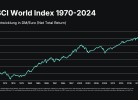By MITCH ZACKS
The first week of September rattled equity investors. The Nasdaq dropped over -6% in two days leading into Labor Day, and at one point had fallen -10% from its high in intra-day trading. In a single day, Apple Inc. shed $179.92 billion off its market cap, marking the biggest one-day loss for a U.S.-listed company ever. For context, Apple’s $180 billion single -day loss is bigger than the individual market capitalizations of 470 of the 500 companies in the S&P 500.
The question now is: will the selling pressure in the equity market spin into a full-on correction, or maybe worse? Yes and no, in my view.
The stock market has seen an impressive bounce off the bottom of the pandemic-induced bear market. Upside volatility tends to invite downside volatility, particularly in areas of the market that did the best off the bottom (namely, Technology). That’s the nature of investing in the stock market – just as investors get comfortable with a rally, the equity market finds a way to deliver a reality check. The market never fails to test investor patience.
Many investors are likely wondering if the selling pressure is likely to continue, and when it might be a good time to get in – or get out – of the market. My advice is to do nothing.
The early stages of bull markets are often volatile and come with a backdrop of fairly weak and inconsistent economic data. Jobs are still being lost, manufacturing and spending activity rebound early only to taper off, and in the current year, a consequential U.S. presidential election looms. Data from the CBOE Volatility Index (VIX) shows that in the last seven U.S. presidential elections, the VIX has risen an average of four points in the month leading up to election day. Short-term volatility is to be expected.
No Sudden Movements
While near-term downside volatility is almost assured, long-term investment strategies should not attempt to factor-in the possibility of pullbacks. Doing so would mean taking the bait of short-term market timing, which is something I never recommend doing.
In the current environment, there is fear building-up about a potentially messy election and an uneven and/or faltering economic recovery. But the risk here, in my view, is allowing thoughts of ‘worst-case scenario’ outcomes to dictate how you manage your investment portfolio. I think it is critical now to keep your feelings about the pandemic and the election separate from your investment decision-making process.
The disconnect between what people expect to happen and what actually happens has already been a major feature of 2020. The ‘worse than the Great Depression’ pandemic forecasts did not come to fruition. Corporate earnings and revenues, for example, took big hits in Q2 2020, but 79.7% of S&P 500 companies beat consensus earnings-per-share estimates and 62.9% beat revenue estimates. On a blended basis, 55.7% of companies exceeded expectations, which represents a very strong showing relative to recent history. The pandemic’s impact on earnings was not as bad as most feared, and stocks rallied over the summer.
It is notable that the equity market’s surge higher was driven by Technology stocks, and the market’s decline is being led on the way down by some of the same companies. It is tempting in this case to think the entire S&P 500 is at the mercy of Big Tech, but I would not overcommit to that line of thinking.
Over time, we know that leadership in the equity markets changes hands often. Technology stocks led throughout the 1990s, but took far longer than other sectors to establish new highs in the next decade. Emerging Markets was the best performing asset class in the 2003 bull market, but lagged significantly in the 2009 – 2020 bull market. Over the last ten years, the top performing asset classes have been Small Caps (2010), REITs (2011), High Yield Bonds (2012), Small Caps (2013), REITs (2014), REITs (2015), Small Caps (2016), Emerging Markets (2017), Cash (2018), and Large Caps (2019). Interestingly for the Technology sector, which is comprised largely of Growth stocks, we also know that Value stocks tend to outperform Growth stocks over long stretches of time. In short – stay diversified.
Bottom Line for Investors
In my view, the current investment environment has all of the classic marks of a correction – a short-term, sharp pullback with a characteristic disconnect: investor sentiment souring based on a widely-known fear, as economic fundamentals quietly improve in the background.
No one can tell you how long the downside volatility will last, whether it will trigger a full-on correction of -10% to -20%, or what areas of the market will outperform on the downside. Claiming otherwise is just guesswork.
Sell-offs often provide strategic opportunities to rebalance portfolios, and if your asset allocation needs adjusting based on a change to your long-term goals or needs, now may be a good time to consider it. Otherwise, my advice is to stay patient and do nothing.
Wenn du keinen Beitrag mehr verpassen willst, dann bestell doch einfach den Newsletter! So wirst du jedes Mal informiert, wenn ein neuer Beitrag erscheint!







